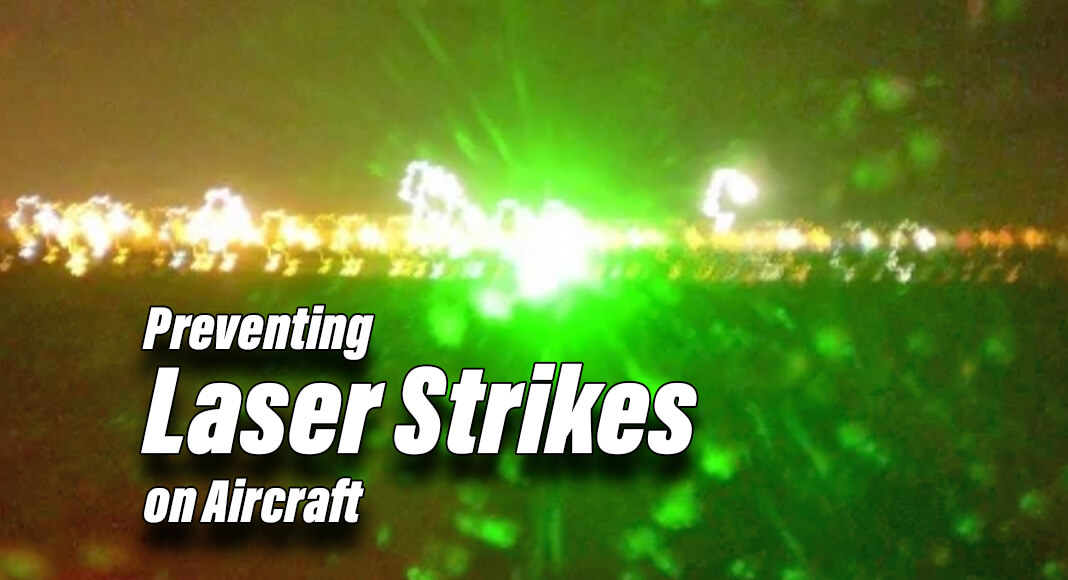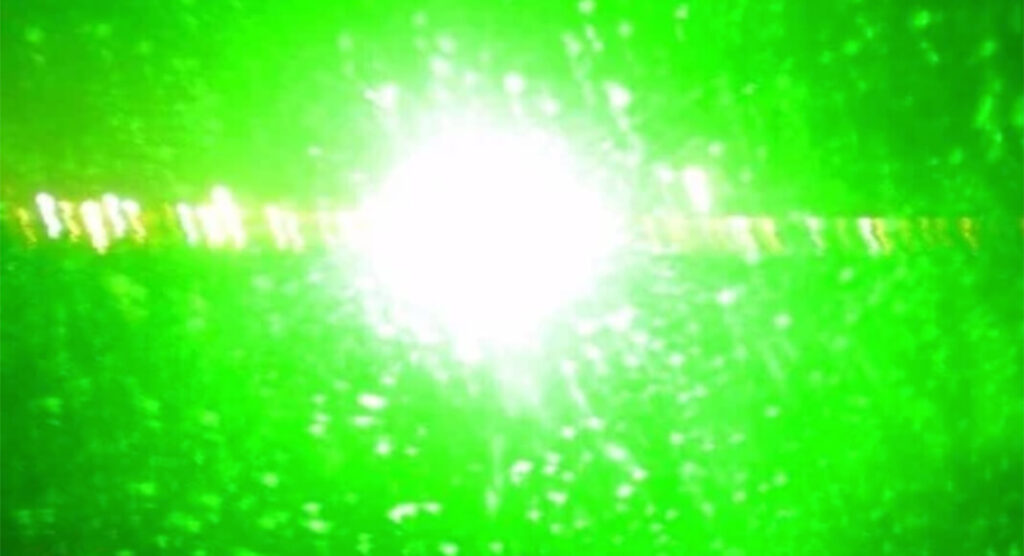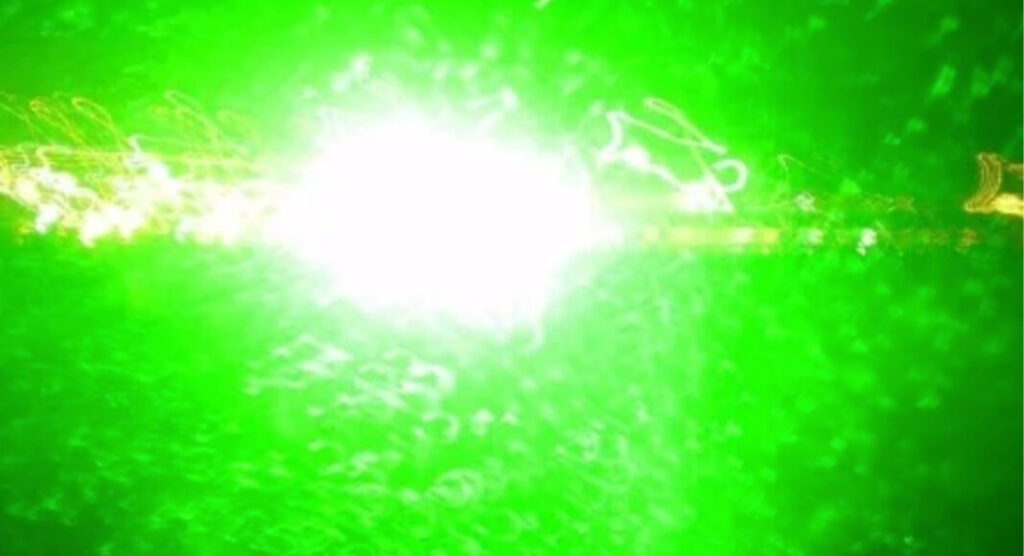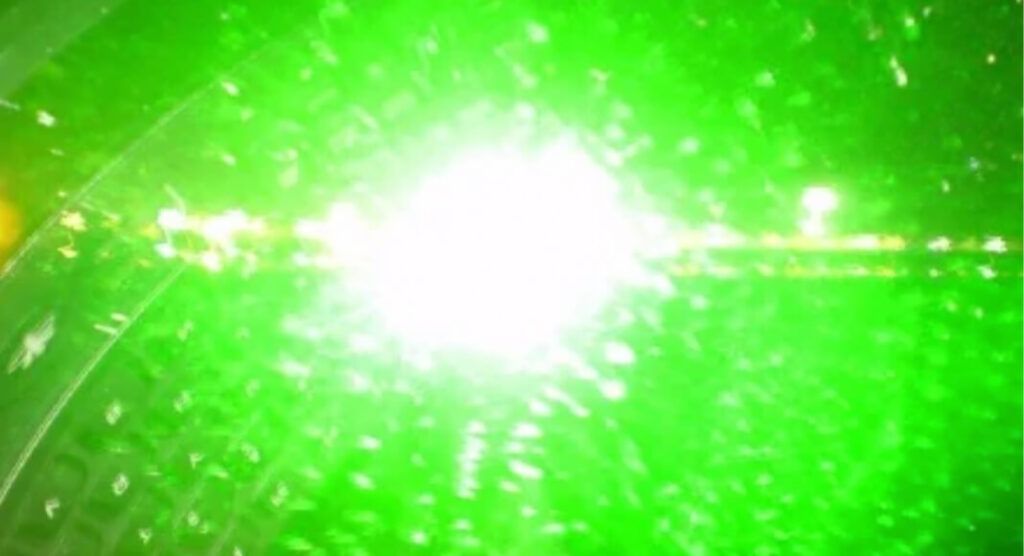
Texas Border Business
When laser beams are aimed at any piloted aircraft, whether military or commercial, what might seem like a tiny beam on the ground can blind aircrew, potentially causing a midair collision or other incident.
In 2023 alone, the Federal Aviation Administration (or FAA) received more than 13,000 reports of laser strikes. And the U.S. Air Force Safety Center’s webpage dedicated to the issue notes that “aircrew are issued laser eye protection glasses before each flight.”
These incidents are both dangerous and illegal.
The FBI is reminding the public to keep their laser pointers out of the sky to protect pilots—and to avoid hefty fines and potential prison time.
Green Lasers Raise Red Flags



In the mid-2000s, as green lasers started becoming more popular with consumers than red ones, the FBI started receiving reports from pilots being struck by green-colored beams, explained Supervisory Special Agent David Gates. He leads FBI Los Angeles’ satellite office at Los Angeles International Airport (LAX).
In 2005, he recalled, the FBI received fewer than 300 laser strike reports. But by 2010, he said, that number had grown to 2,800. That increase concerned the FBI, since laser strikes can distract or cause physical damage to pilots, he said. When laser beams hit cockpit windows, the glare they create can cause flash blindness, a condition in which vision is affected after exposure to the source of light, Gates explained. The FBI Los Angeles images below depict what that glare looks like from the pilot’s perspective.
From left to right, the photos above show what glare from a laser beam located 2,600 feet; 1,000 feet; 800 feet; and 500 feet away from an aircraft looks like from within the aircraft’s cockpit.
“The last thing that we really want as a society is for people flying helicopters or planes to be blinded any time, but specifically when they’re trying to land and take off,” Gates said.
The issue of laser strikes can also have a counterterrorism nexus. Sometimes, the FBI needs to determine whether someone purposefully aimed a laser at an aircraft in an attempt to bring it down, explained Supervisory Special Agent Melissa Ventresca. She leads the International Counterterrorism Squad at FBI San Antonio’s satellite office in Austin, Texas, which also covers Austin-Bergstrom International Airport.
The Science Behind the Risk
Laser pointers don’t need to be pointed directly into a pilot’s eye to do damage, Gates explained.
“If you’re on the ground aiming a laser pointer at a plane or a helicopter, it’s not just that little tiny point,” he said. Once a laser beam reaches the aircraft, cockpit windows reflect it, filling the space with blinding light. “By the time it reaches the cockpit and the pilot is looking out, that beam of light might be the size of a watermelon or a cantaloupe,” Gates explained.
And, according to the FAA, laser beams—and their reflections—can be especially dangerous to pilots if they pop into their fields of view while they have their sights set on something far away—such as a runway.
“Laser exposure is most hazardous when a direct laser beam, or its specular (mirrorlike) reflection, enters the pupil along the axis of vision when the eye is focused on a distant object,” the FAA writes. “The energy density of the laser beam can be intensified up to 100,000 times by the focusing action of the eye.”
The further the laser is from an aircraft, the wider the light beam grows.
When FBI agents seize laser pointers used in these kinds of strikes, Gates says, they give the pointers to physicists and other laser specialists for scientific analysis. These experts then determine that laser’s strength and chart out the relative diameter of its beam based on the distance between the laser pointer and the aircraft it targeted.
And because of how the human eye perceives light, green is the most dangerous color of laser that an aircraft can be struck with, an FAA brochure explains. The FBI most often hears reports of strikes by green and purple beams, Gates noted.
If an aircraft is hit with a laser, the best-case scenario would be a distracted pilot, which could still lead to “any number of errors,” Ventresca said. But if a laser strike damages pilots’ retinas and corneas, that could cause them to make “all sorts of other failures that could be catastrophic,” potentially resulting in “a mass casualty event,” she said.
“If we can prevent one catastrophe, prevent one pilot from being blinded, that makes it worth it.”
Melissa Ventresca, supervisory special agent, FBI San Antonio
Investigating Laser Strikes
The first federal laser law was enacted in 2012, when Congress passed it as part of the reauthorization of the Federal Aviation Administration.
Before 2012, the Bureau pursued laser pointer investigations under a law forbidding “destruction of an aircraft,” which Gates likened to “trying to smash a square peg into the round hole.”
The 2012 federal statute makes it illegal for people to “knowingly” point a laser pointer’s beam “at an aircraft”—whether private, commercial, or military—or its flight path. Most importantly, it attaches consequences to this action: A monetary fine of up to $250,000 and/or a federal prison sentence of up to five years. On top of that, the FAA’s website notes that it “can impose civil penalties of up to $11,000” each time someone aims a laser beam at an aircraft.
“That suddenly gave us real teeth in enforcement,” Gates said of the statute. “It made shining a laser pointer at an aircraft a five-year maximum penalty felony, which is a really big deal.”
And, as Gates recalls, it paid off: He opened his first investigation into a laser strike violation within two months of the law’s implementation, which eventually resulted in a conviction.
According to the FAA, the profile of individuals responsible for laser strikes differs between different locations of the country. But when it comes to FBI investigations into such incidents, Gates said, “we’re looking for that person who’s intentionally tracking an aircraft, who does it over and over.”
He said that red flags for FBI investigators include:
- A laser beam that follows an aircraft as it moves
- A laser beam that keeps coming at an aircraft, even after its position has changed
- Clusters of laser strikes reports from aircraft traversing the same stretch of airspace
The FBI commonly catches laser strike offenders in collaboration with federal and local law enforcement partners, Gates explained.
The universally accepted procedure is that an air traffic controller notifies local law enforcement dispatch, who will then notify law enforcement air units and ground patrols, if available, the FAA said.
From there, if a local police helicopter deploys to the scene and gets lased, they can use technology like infrared cameras to pinpoint the exact location the laser beam came from.
Helicopter crews can then reach out to their agencies for on-the-ground backup or call the FBI for assistance. An October 2022 laser strike against an Austin Police Department helicopter led to the arrest and conviction of two Texas men, Ventresca noted.
Bureau partnerships with local, state, and federal partners—as well as with commercial airlines—are key to ensuring that members of the aviation and law enforcement communities know how to seek the Bureau’s help in addressing laser strikes. This is especially important in states and municipalities that lack laser-strike laws of their own, since local or state authorities can ask the FBI to investigate incidents in those areas as federal crimes.
Help Us Protect the Skies
We’ve all likely mistaken an airplane for a star or other celestial body at least once in our lives. But pointing out a possible star with a laser could endanger the aircrew if your suspicion is wrong. For this reason, it’s best to keep your laser pointers out of the sky.
If you spot someone aiming a laser at the sky in a suspicious manner, you can report it to the FBI by calling 1-800-CALL-FBI (1-800-225-5324) or visiting tips.fbi.gov. You can also report laser strikes to the FAA.
You should contact the FBI immediately if you see someone playing with lasers near—or otherwise posing a threat to—an airport.
Finally, if you’re thinking of gifting a laser pointer to someone—especially if they’re a minor—educate them on the very real dangers of misusing these devices.
“If we can prevent one 15-year-old from ending up with federal or state charges or even the large fine, that’s a win,” Ventresca said. “If we can prevent one catastrophe, prevent one pilot from being blinded, that makes it worth it.”
Resources:














